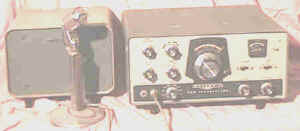WB9CTH - 1970 Station Tour
Greg Ordy (W8WWV)
My first amateur radio station was in DeKalb, Illinois. DeKalb is located
about 60 miles west of Chicago, and is the home of Northern Illinois University. I
obtained my license during my high school years. My first real radio was a Heathkit
HW-100. For many decades, Heathkit sold a wide range of high quality kit products. As
electronic components became smaller, more integrated, and more complex, the Heathkit
approach became impractical, as did the company. Still, their radio products have a
special meaning to those that built and operated them.
 |
Here are the components of the HW-100 package.The
transceiver was combined with a speaker/power supply unit and a microphone. |
 |
The HW-100 front panel was simple, but highly functional.
AF and RF gain in the lower right, below the meter switch. In the upper right you might be
able to detect a small switch that I added to select two different AGC rates. The VFO
tuned 500 KHz, and was labeled 0 - 500. The bandswitch placed the VFO at the start of the
80, 40, 20, 15, and 10 meter bands. This was long before WARC bands. |
 |
Here's a look inside the radio. For the very young in the
audience, the funny looking tall objects are vacuum tubes. The finals, a pair of 6146's,
were located in the shielded box in the rear left corner. With 20 vacuum tubes glowing
away, the radio could become quite warm. If you have visited my pets page, you will have
met my cat, Chan, who used to love to sleep
on the radio while it was powered up. |
During the DeKalb years, we lived in an apartment building. Thankfully, it
was on the top floor (the third floor), and on the end. This gave me at least some glimmer
of hope for an outside antenna. I experimented with several configurations, and settled on
a single end-fed long wire antenna, which ran from my bedroom window, around the corner of
the building, across the side of building, around the next corner, and terminated at our
balcony. What made this design work was the fact that the building facade was brick, and I
could hide the thin wire along the mortar line between the bricks. It provided mechanical
support as well as some degree of disguise.
Here's a picture of the building. I have highlighted the location of the
wire. With this wire, I worked the world. Being near the top of the sunspot cycle didn't
hurt either.

Back to my Amateur Radio Page
Last update:
Sunday, September 29, 2002 11:04 PM
Back to my Home Page



